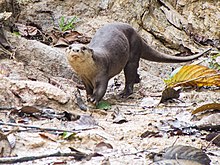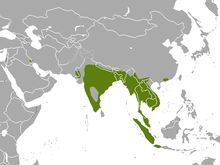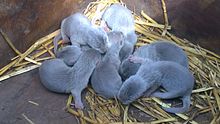Smooth-coated otter
| Smooth-coated otter | |
|---|---|

| |
| In Borneo, Malaysia | |
| Scientific classification | |
| Domain: | Eukaryota |
| Kingdom: | Animalia |
| Phylum: | Chordata |
| Class: | Mammalia |
| Order: | Carnivora |
| Family: | Mustelidae |
| Genus: | Lutrogale |
| Species: | L. perspicillata
|
| Binomial name | |
| Lutrogale perspicillata (I. Geoffroy Saint-Hilaire, 1826)
| |

| |
| Smooth-coated otter range | |
| Synonyms | |
|
Lutra perspicillata | |
The smooth-coated otter (Lutrogale perspicillata) is a freshwater
is relatively smooth, and somewhat shorter in length than that of other otter species.Characteristics
The smooth-coated otter has a short, sleek coat of dark-brown to reddish-brown fur along its back, with lighter grayish brown on its underside. It is distinguished from other otter species by a more "rounded" head, and by having a vaguely diamond-shaped, hairless nose. The tail is flattened, in contrast to the more rounded or cylindrical tails of other otters. The legs are short and strong, with large, webbed feet bearing strong and sharp claws for handling slippery fish. The smooth-coated otter is a relatively large otter species, weighing from 7–11 kg (15–24 lb) and measuring around 59–64 cm (23–25 in) in head-body length with a 37–43 cm (15–17 in) long tail. Females have two pairs of teats with which they nurse small litters of several young.[2]
Taxonomy
Lutra perspicillata was the
- Lutrogale perspicillata sindica — proposed by Reginald Innes Pocock in 1940, when seven pale skins of smooth-coated otters were collected and documented in Sukkur and Khairpur Districts of Sindh Province, Pakistan.[5]
- Lutrogale perspicillata maxwelli — proposed by
The smooth-coated otter is the only living species in the monotypic genus Lutrogale. Three regional subspecies are currently recognised:[2]
- L. p. perspicillata — found across India, Nepal, southwestern Yunnan, most of mainland Indochina and Southeast Asia, as well as on Sumatra and Java, Indonesia.
- L. p. sindica — found in Khyber Pakhtunkhwa, Punjab and Sindh Provinces, Pakistan.[7]
- L. p. maxwelli — found in Iraq, primarily near the Tigris River.[8]
The smooth-coated otter, together with the
Distribution and habitat

The smooth-coated otter is distributed in
The population in the
In Gujarat, smooth-coated otters were documented near lakes, canals and mangroves in the outskirts of Surat in 2015.[13] In Singapore, smooth-coated otters have adapted well to urban environments, and have been observed to use urban structures like gaps under buildings as alternatives for holts. They also use staircases and ladders to get in and out of concrete canals with vertical or near‐vertical banks.[14] This population is well-protected and steadily increasing, with some families, such as the Bishan otter family, becoming a common sight and attracting media attention.[15]
Behaviour and ecology
The smooth-coated otter lives in groups of up to 11 individuals. They rest on sandy riverbanks and establish their dens under tree roots or among boulders. Observations in
They communicate through vocalisations such as whistles, chirps, and wails.[2]
Diet
Smooth-coated otters were observed to forage on river banks among tree trunks.[16] They feed mainly on fish including Trichogaster, climbing gourami and catfish. During the rice planting season, they also hunt rats in rice fields. Snakes, amphibians and insects constitute a small portion of their diet.[18] Especially in areas where they share habitat with other otter species, they prefer larger fish, typically between 5 and 30 cm (2.0 and 11.8 in) in length.[10][19]
In Kuala Selangor Nature Park, an otter group was observed hunting. They formed an undulating, slightly V-shaped line, pointing in the direction of movement and nearly as wide as the creek. The largest individuals occupied the middle section. In this formation, they undulated wildly through the creek, causing panic‑stricken fish to jump out of the water a few metres ahead. They suddenly dived and grasped the fish with their snouts. Then they moved ashore, tossed the fish up a little on the muddy part of the bank, and swallowed it head‑first in one piece.[20]
Reproduction

Smooth-coated otters form small family groups of a mated pair with up to four offspring from previous seasons.[21] Copulation occurs in water and lasts less than one minute.[22]
As long as the food supply is sufficient, they breed throughout the year, but where they depend on monsoon precipitation, they breed between October and February. The largest recorded wild-born litter of seven pups was observed in Singapore in November 2017.[23] Pups are born after a gestation period of 60 to 63 days, with a usual litter size of up to five pups. The mothers give birth to and raise their young in a burrow near water. They either construct such a burrow themselves, or they take over an abandoned one. At birth, the pups are blind and helpless, but their eyes open after 10 days. They are weaned at about three to five months and reach adult size at about one year of age, and sexual maturity at two or three years.[2]
Threats
The smooth-coated otter is threatened by
Along the Chambal River in India, smooth-coated otters are most vulnerable during winter when they rear young. During this season, they are disturbed by humans harvesting crops and removing wood along rocky stretches of the river.[24]
Six juvenile smooth-coated otters were discovered in a bag left at
Conservation
The smooth-coated otter is a protected species in most range countries and listed globally as a
Cultural significance
In southern Bangladesh, smooth-coated otters are used for commercial fishing. They are bred in captivity and trained to chase fish into fishing nets. By 2011, this fishing technique was used by about 300 fishermen, with an additional 2,000 people indirectly dependent on the technique for their livelihood.[28]
References
- ^ . Retrieved 10 December 2022.
- ^ doi:10.1644/786.1.
- ^ Geoffroy Saint-Hilaire, É. (1826). "Le Simung". In Audouin, I. B.; Bory de Saint-Vincent, M. (eds.). Dictionnaire classique d'Histoire Naturelle. Vol. 9. Paris: Société D'Histoire Naturelle. p. 519.
- ^ Gray, J. E. (1865). "Revision of the Genera and Species of Mustelidae contained in the British Museum". Proceedings of the Zoological Society of London. January 1865: 100–154.
- ^ Pocock, R. I. (1940). "Notes on some British Indian otters, with descriptions of two new subspecies". Journal of the Bombay Natural History Society. 41: 514–517.
- .
- ^ Khan, W. A.; Bhagat, H. B. (2010). "Otter Conservation in Pakistan". IUCN Otter Specialist Group Bulletin. 27 (2): 89–92.
- ^ a b Al-Sheikhly, O. F.; Nader, I. A. (2013). "The Status of the Iraq Smooth-coated Otter Lutrogale perspicillata maxwelli Hayman 1956 and Eurasian Otter Lutra lutra Linnaeus 1758 in Iraq" (PDF). IUCN Otter Specialist Group Bulletin. 30 (1): 18–30. Archived (PDF) from the original on 2017-08-07. Retrieved 2015-03-18.
- PMID 28128366.
- ^ .
- ^ Narasimmarajan, K.; Hayward, M.W. & Mathai, M.T. (2021). "Assessing the occurrence and resource use pattern of Smooth-coated Otters Lutrogale perspicillata Geoffroy (Carnivora, Mustelidae) in the Moyar River of the Western Ghats Biodiversity Hotspot" (PDF). IUCN Otter Specialist Group Bulletin. 38 (1): 45–58. Archived (PDF) from the original on 2021-10-30. Retrieved 2021-11-02.
- ^ Salim, M. A.; Abd, I. M.; Abdulhassan, N. A. & Minjal, M. Sh. (2009). Burnham, D.; Hudson, V. & Bachmann, A. (eds.). Key Biodiversity Survey of Southern Iraq: 2009 Site Review (PDF). Nature Iraq. Archived from the original (PDF) on 2013-12-17. Retrieved 15 April 2013.
- ^ Trivedi, K. & Joshi, P. (2018). "Photographic documentation and distribution of Smooth-coated Otter (Lutrogale perspicillata) (Geoffroy 1826) in Surat, Gujarat". IUCN Otter Specialist Group Bulletin. 35 (1): 31–36.
- .
- ^ Turrell, C. (2020). "Cheeky otters are thriving in Singapore—and adapting quickly to big city life". National Geographic. Archived from the original on 2021-08-09. Retrieved 2021-08-09.
- ^ a b Shariff, S. M. (1984). "Some observations on otters at Kuala Gula, Perak and National Park, Pahang" (PDF). Journal of Wildlife and Parks. 4: 75–88. Archived (PDF) from the original on 2020-08-07. Retrieved 2019-11-24.
- CiteSeerX 10.1.1.507.9967.
- ^ Foster-Turley, P. (1992). Conservation ecology of sympatric Asian otters Aonyx cinerea and Lutra perspicillata (Ph.D. Dissertation). Gainesville, Florida: University of Florida. Archived from the original on 2020-08-07. Retrieved 2019-11-24.
- .
- ^ van Helvoort, B. E.; Melisch, R.; Lubis, I. R.; O'Callaghan, B. (1996). "Aspects of Preying Behaviour of Smooth Coated Otters Lutrogale perspicillata from Southeast Asia". IUCN Otter Specialist Group Bulletin. 13 (1): 3–7. Archived from the original on 2013-12-17. Retrieved 2012-11-10.
- S2CID 85376086.
- .
- ^ Sivasothi, N. & Khoo, M.D.Y. (2018). "Observations of the variation in group structure of two urban Smooth-Coated Otter Lutrogale perspicillata groups in the central watershed of Singapore". IUCN/SSC Otter Specialist Group Bulletin. 35 (3): 148–154. Archived from the original on 2020-07-20. Retrieved 2020-11-23.
- .
- ^ Shepherd, C. R. & Tansom, P. (2013). "Seizure Of Live Otters In Bangkok Airport, Thailand". IUCN Otter Specialist Group Bulletin. 30 (1): 37–38. Archived from the original on 2019-08-03. Retrieved 2019-11-24.
- ^ Gomez, L. & Bouhuys, J. (2018). Illegal Otter Trade in Southeast Asia (PDF). Kelana Jaya, Selangor, Malaysia: Traffic Southeast Asia Regional Office. Archived (PDF) from the original on 2019-07-25. Retrieved 2019-11-24.
- ^ DTE Staff (2019). "CITES CoP 2019: Otters given highest protection from trade". DownToEarth. Archived from the original on 2019-08-30. Retrieved 2019-08-30.
- ^ Feeroz, M. M.; Begum, S. & Hasan, M. K. (2011). "Fishing with Otters: a Traditional Conservation Practice in Bangladesh". IUCN Otter Specialist Group Bulletin (28A, Proceedings of XIth International Otter Colloquium): 14–21. Archived from the original on 2017-06-30. Retrieved 2012-06-21.
External links
- "Lutrogale perspicillata (Geoffroy Saint-Hilaire, 1826), the Smooth-Coated Otter". IUCN Otter Specialist Group.
- "Smooth-coated otter". Animal Diversity Web.
- "Smooth-coated otter". ARKive. Archived from the original on 2010-12-23.
- Mijbil The Otter- CBSE Class 10 NCERT- English- First Flight.



